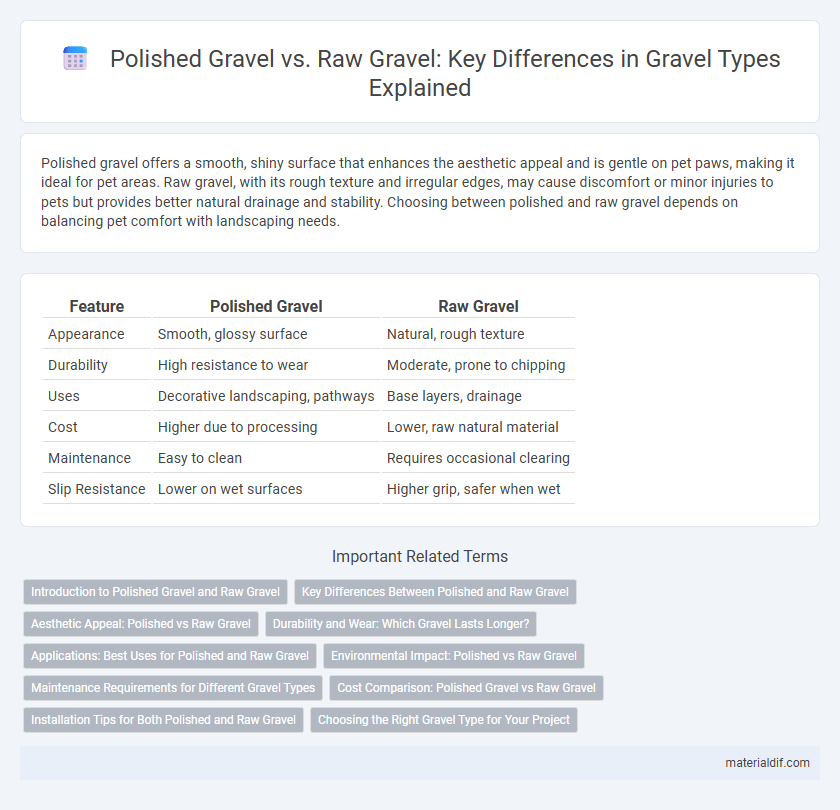Polished gravel offers a smooth, shiny surface that enhances the aesthetic appeal and is gentle on pet paws, making it ideal for pet areas. Raw gravel, with its rough texture and irregular edges, may cause discomfort or minor injuries to pets but provides better natural drainage and stability. Choosing between polished and raw gravel depends on balancing pet comfort with landscaping needs.
Table of Comparison
| Feature | Polished Gravel | Raw Gravel |
|---|---|---|
| Appearance | Smooth, glossy surface | Natural, rough texture |
| Durability | High resistance to wear | Moderate, prone to chipping |
| Uses | Decorative landscaping, pathways | Base layers, drainage |
| Cost | Higher due to processing | Lower, raw natural material |
| Maintenance | Easy to clean | Requires occasional clearing |
| Slip Resistance | Lower on wet surfaces | Higher grip, safer when wet |
Introduction to Polished Gravel and Raw Gravel
Polished gravel consists of smooth, rounded stones that have been mechanically tumbled or naturally worn by water, resulting in a glossy, refined surface ideal for decorative landscaping and pathways. Raw gravel maintains its natural, rough texture with sharp edges and an irregular shape, making it suitable for drainage, construction, and foundational applications due to its superior compaction properties. Both types differ significantly in appearance, texture, and functionality, influencing their best use cases in landscaping and construction projects.
Key Differences Between Polished and Raw Gravel
Polished gravel is smooth and glossy due to a tumbling process that removes rough edges, making it ideal for decorative landscaping and pathways. Raw gravel retains its natural, rough texture and edges, offering better traction and drainage for construction and road base applications. The key differences lie in their texture, appearance, and typical uses, with polished gravel favored for aesthetics and raw gravel for functional stability.
Aesthetic Appeal: Polished vs Raw Gravel
Polished gravel offers a smooth, glossy surface that enhances landscaping aesthetics by reflecting light and showcasing natural colors vividly. Raw gravel features a rough texture and matte finish, providing a rustic and natural appearance suited for garden paths and driveways. Choosing between polished and raw gravel depends on desired visual impact, with polished gravel highlighting elegance and raw gravel emphasizing organic charm.
Durability and Wear: Which Gravel Lasts Longer?
Polished gravel features a smooth surface that reduces friction and resists weathering, making it more durable for high-traffic areas. Raw gravel, with its rough and jagged edges, tends to break down faster under mechanical stress and environmental exposure. Durability comparisons show polished gravel generally lasts longer due to its enhanced resistance to wear and abrasion.
Applications: Best Uses for Polished and Raw Gravel
Polished gravel offers a smooth, aesthetically pleasing surface ideal for decorative landscaping, driveways, and walkways where a refined look is desired. Raw gravel, with its natural texture and angular edges, provides excellent drainage and stability, making it suitable for construction bases, erosion control, and heavy-duty pathways. Choosing between polished and raw gravel depends on whether the application prioritizes visual appeal or functional support.
Environmental Impact: Polished vs Raw Gravel
Polished gravel typically undergoes extensive processing, which increases energy consumption and carbon emissions compared to raw gravel, extracted and used in its natural state. Raw gravel provides a more environmentally friendly option by minimizing industrial intervention and decreasing habitat disruption during extraction. Choosing raw gravel supports sustainable construction practices by reducing resource depletion and lowering the overall ecological footprint.
Maintenance Requirements for Different Gravel Types
Polished gravel requires less maintenance due to its smooth surface, which resists weed growth and compaction, making it ideal for pathways and driveways. Raw gravel often necessitates regular raking and weed control to maintain its appearance and functionality, as its rough texture allows for soil and plant infiltration. Choosing between polished and raw gravel depends on the desired aesthetic and the willingness to perform ongoing upkeep tasks.
Cost Comparison: Polished Gravel vs Raw Gravel
Polished gravel typically costs 25-40% more than raw gravel due to the additional processing and finishing techniques involved, increasing labor and equipment expenses. Raw gravel remains the more economical option for large-scale projects or budget-conscious landscaping where aesthetic refinement is less critical. The price difference varies based on regional supply chains and the specific type of gravel used, with polished gravel often preferred for decorative applications despite the higher cost.
Installation Tips for Both Polished and Raw Gravel
Polished gravel requires a well-compacted base and careful leveling to ensure a smooth, stable surface ideal for driveways or pathways, while raw gravel benefits from a thicker base layer to prevent shifting and improve drainage. For polished gravel installation, use a mechanical compactor for even pressure distribution, whereas raw gravel may require periodic replenishment to maintain an even surface. Both types demand proper edging to contain the gravel and reduce migration over time.
Choosing the Right Gravel Type for Your Project
Polished gravel offers a smooth, refined appearance ideal for decorative landscaping and pathways, enhancing aesthetic appeal while providing effective drainage. Raw gravel, with its natural, unprocessed texture, is more suitable for construction projects requiring strong foundational support and better interlocking properties. Carefully assessing your project's functional needs and visual goals ensures the right gravel type enhances durability and design efficiency.
Polished gravel vs Raw gravel Infographic

 materialdif.com
materialdif.com